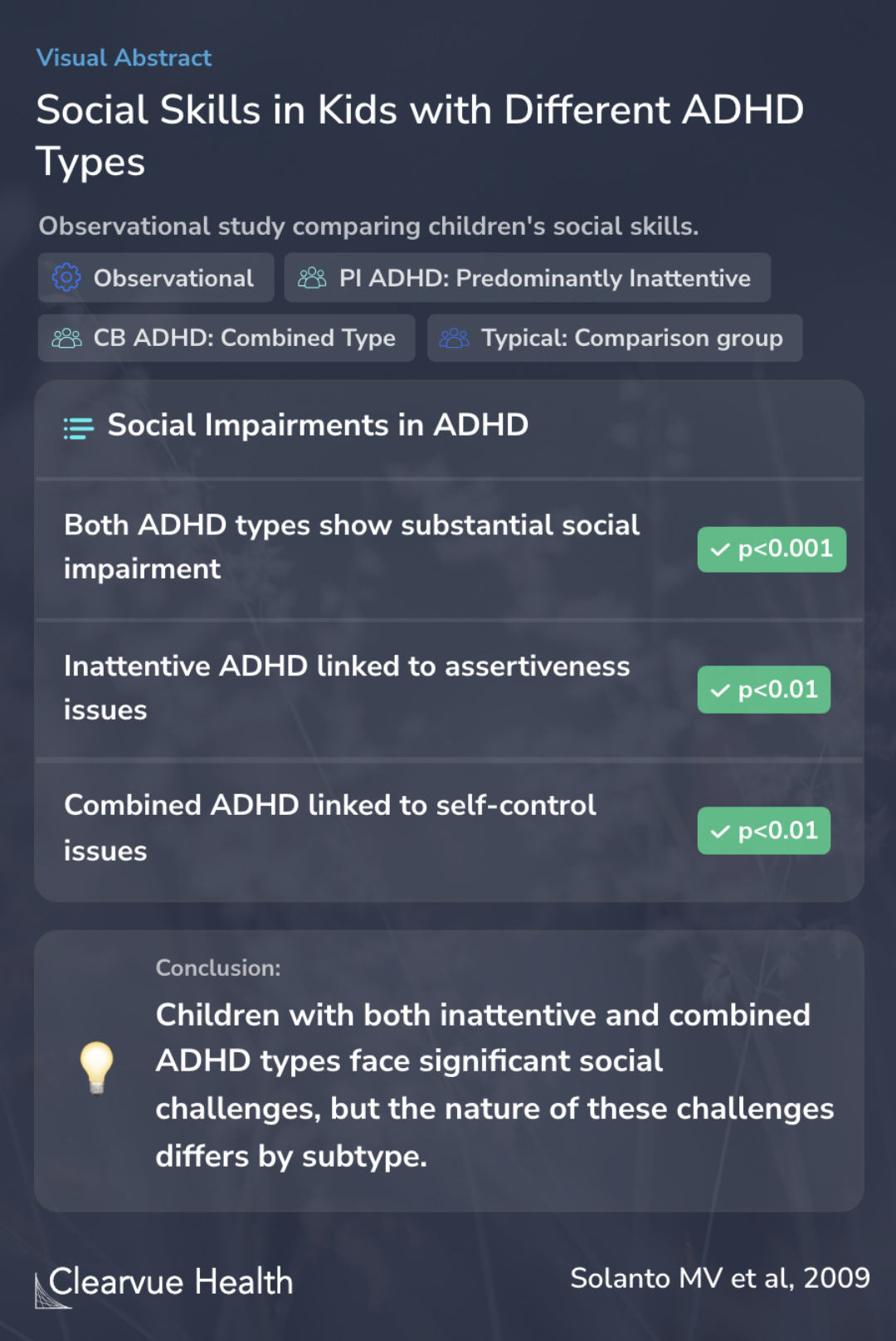Dark
Visual Abstract
Social functioning in predominantly inattentive and combined subtypes of children with ADHD
Social Skills in Kids with Different ADHD Types
Solanto MV, Pope-Boyd SA, Tryon WW, Stepak B
Summarized by:
January 1, 2024
study source
J Atten Disord
Jul 2009

Social Skills in Kids with Different ADHD Types
🔎
What they studied
Comparing social skills in kids with different types of ADHD, considering their other conditions and medication.
💡
What they found
Kids with both ADHD types had major social challenges. Their issues varied: some struggled to be assertive, others with self-control.
👩⚕️
Why it matters
Understanding these differences can help create better help for kids with ADHD, focusing on their specific social challenges.
Objectives
The study aimed to examine how children with two different types of Attention Deficit/Hyperactivity Disorder (ADHD) - the Combined (CB) and Predominantly Inattentive (PI) subtypes - manage in social situations. This was done by taking into account other health conditions and medications the children might be on, which could affect previous research results.
Study Quote
The objective of this study was to compare the social functioning of children with the Combined (CB) and Predominantly Inattentive (PI) subtypes of Attention Deficit/Hyperactivity Disorder (ADHD), controlling for comorbidity and medication-status, which may have confounded the results of...
Show More
Methods
Parents and teachers played a key role in this study. They observed children who were rigorously diagnosed with either the PI or CB subtypes of ADHD. These children were not on medication. Additionally, children who did not have ADHD were also included for comparison. Everyone involved rated the children's social skills using a tool called the Social Skills Rating Scale (SSRS).
Study Quote
Parents and teachers of rigorously diagnosed unmedicated children with PI or CB subtypes of ADHD, and typical comparison children, rated them on the multidimensional Social Skills Rating Scale (SSRS).
Results
After considering factors like oppositionality and anxiety, the study found that children with both ADHD subtypes faced significant social challenges. Interestingly, the type of difficulty varied depending on the subtype of ADHD. Children with PI ADHD had trouble with assertiveness, while those with CB ADHD struggled with self-control. This suggests that each ADHD subtype has its unique social challenges.
Study Quote
After co-varying for oppositionality and anxiety, social impairment was substantial and equivalent in both ADHD groups whether rated by parent or teacher. In addition, when rated by teacher, the nature of the deficits varied by subtype: Children with PI were impaired in assertiveness, wh...
Show More
Conclusions
The study concludes that significant social impairments are present in children with both inattentive and combined types of ADHD. However, the nature of these impairments differs based on the subtype. This finding is crucial because it points to the need for tailored interventions to help children with different types of ADHD.
Study Quote
The study shows that children with the Predominantly Inattentive and Combined subtypes of ADHD exhibit substantial social impairments, with different areas of dysfunction. These results emphasize the importance of targeted interventions to address the specific social needs of children wi...
Show More
Key Takeaways
Significant social challenges in all ADHD types
Children with both inattentive and combined ADHD types face major social difficulties, stressing the need for targeted support.
Different challenges for different subtypes
Kids with predominantly inattentive ADHD struggle with assertiveness, while those with combined subtype struggle with self-control.
Need for tailored interventions
This study underlines the importance of creating specific interventions to address the varied social needs of kids with different ADHD subtypes.
Context
This study adds to a growing body of research on ADHD and its varied impacts on children's lives. For instance, a 2020 study by Molavi et al. explored how different ADHD subtypes are linked to cognitive abilities and self-esteem in children. It found that children with different ADHD types displayed varied thinking abilities and levels of self-esteem. This suggests that, much like the current study, different ADHD types might require unique forms of support.
In another study from 2005 by Lahey BB et al., the focus was on the stability of ADHD subtype classifications over time in children. It revealed that while most children's ADHD diagnoses persisted, they often shifted between different subtypes. This highlights the complexity of ADHD and the possibility that subtype classifications may change as children grow.